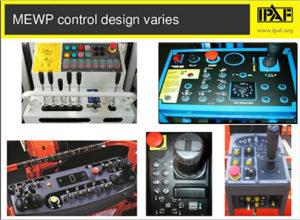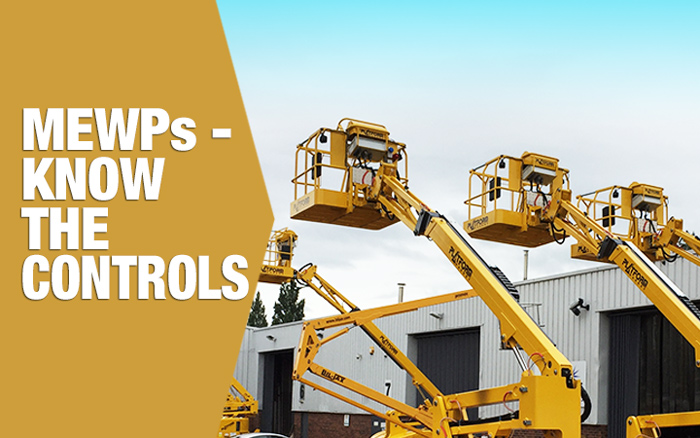
Safer Working at Height
25 February 2018
Reducing trapping and crushing incidents
Serious trapping / crushing accidents and deaths have been reported in all industries, particularly for temporary working at height in construction and maintenance sectors along with a variety of other trades including electrical contractors, painters and decorators, arborists and tree services.
Many accidents are caused by MEWP users whose main job is electrician/painter or similar activity and use powered access platforms infrequently. With infrequent use it is easy to forget the initial training both for the MEWP being used and the safety and rescue procedures that should be in place.
Although powered access platforms make working at height safer and more efficient, it is both employers and users who are liable if the people in charge of the machinery are not properly trained.
Under UK health and safety laws and work at height regulations, training in the use of powered access is compulsory. Anyone working with the equipment needs to know how to inspect it, to operate it safely, and to recognise and avoid any potential hazards. As well as this general training, they should also be given familiarisation training on the specific model that they will be working with.
The risk assessment from the ground should identify any overhead or adjacent objects that may cause problems. Many MEWP occupants have been trapped against overhead or adjacent obstructions whilst in the platform, especially when the operator has been trapped over the controls.
There are a number of key factors have been identified that contribute to operators being trapped or crushed whilst within the powered access platform basket.
• Working alone – if nobody sees or hears the problems in the raised basket, the resultant delay in getting help can be crucial. All MEWPs should be fitted with ground controls for emergency rescue with the ground member of the team being fully trained in their use. (Even older machines can be retro-fitted with ground controls.)
• Operator error – is still a major factor in working at height accidents. There is no standard control panel on MEWPs and if the infrequent operator needs to change to a different machine, the wrong lever may be operated or even accidentally knocked if the controls are fitted very close together.
• Overhead hazards – failure to perceive and identify potential hazards in the surrounding workplace area, not just above but all round. In tree work falling branches may snag and bring down adjacent branches directly into the basket.
• Leaning over the side rail – accidents have been reported where the operator has been leaning over the side rail whilst manoeuvring.
• Poor ground conditions – failure to allow for bad weather, hidden drains and soft sub-soil is another contributor.
Many of these risk scenarios can be reduced by good and frequent training. Every manager and operator needs to ensure their training is current and that their PAL card is valid for the machine being used.
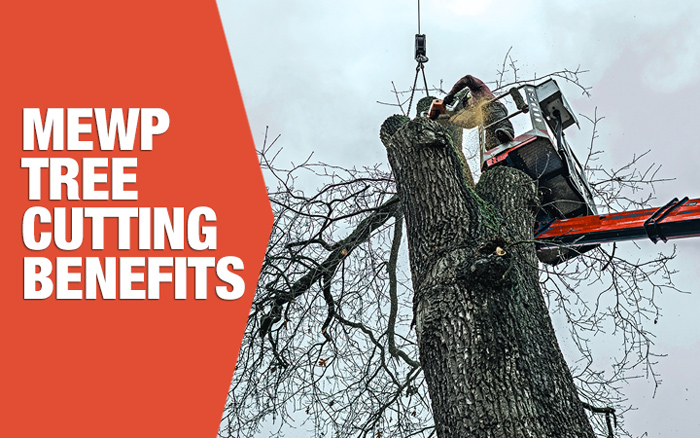
Tree Cutting Benefits Of Powered Access Platforms
18 February 2018
The Advantages of Powered Access Platforms for Arborists
The correct tree trimming tools and equipment are essential but often bulky when trying to work safely at height. To get people, tools and equipment to the correct height there are times when traditional working solutions can limit productivity and endanger the arborist.
Powered access platforms offer a flexible way to reach jobs at height – they are fully mobile and can access areas with restricted space, improve site safety, and save money.
Mobility
Spider lift access platforms have the advantage of being transported, set up and utilised quickly and easily with flexibility, depending on the demands of the job. Spider lift access platforms are lightweight with low ground pressure, especially advantageous when working near garden pathways and manicured lawns.
Placing the MEWP carefully and raising the platform allows the operator to get a close view of potential tree cutting problems that are not always seen from the ground. Identification of dangerous branches and potential fall areas for cut wood will help reduce the risk of accidents. Tools can be safely taken to where they are needed without the risk of hauling up by rope.
Safety
With no arduous climbing to the crown and working from a stable platform, the arborist can get a good view of the work that needs to be done without putting themselves and others in a hazardous situation.
Familiarisation with the powered access equipment manual is essential reading along with a pre-work risk assessment. Training in the use of access equipment is required by law and will benefit businesses as the equipment can be used safely, quickly and efficiently by a small number of staff.
Cost effective
Reducing the time needed to manually climb and haul tools up into the tree can reduce the time needed for individual jobs. More jobs done in a week will help raise productivity and profit. In addition the reduction of time needed at the location can mean less obstruction and inconvenience to others.
Using a powered access platform when providing a tree surgeon service enables the optimum tools to be used when working on the tree. Working efficiently and effectivity will raise the quality of work done leading to higher customer satisfaction and recommendation of your tree services.
Summary
Whether you are looking to buy or hire the equipment for arboreal work, powered access platforms, are mobile, safe and flexible. They resolve a number of issues posed by traditional rope climbing and lifting methods including access to hard to reach and potentially hazardous areas. With the correct procedures in place, health and safety risks are reduced whilst jobs can be completed in less time. Whatever the size and location of your job, they are easy to operate and install, safe to use and can cater for a range of needs and requirements to enhance your tree services.
Promax Access provides advice in choosing from their range of Spider Lift Access Platforms ideally suited to your tree surgeon’s business.
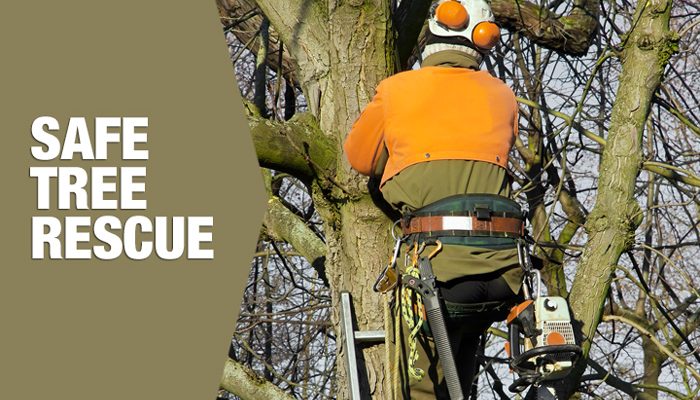
Safe rescue for Arborists
11 February 2018
Aerial Rescue from Powered Access Platforms
Even with the right equipment tree cutting at height demands safe working practices. Good climbing techniques should include the regular practice of rescue for operatives who get into difficulty. A minimum of two people must be present during tree climbing and working at height operations. At least one ground member must be competent and trained to perform a rescue from a raised platform.
Good planning is essential:
• A daily programme for the tree work should be established.
• A contact procedure established with a designated person
• Two-way radio / mobile phone communication between ground and raised platform
The Risk Assessment
As part of the pre-work risk assessment, emergency procedures for the recovery and evacuation of casualties needs to be established. All operatives and ground workers need to be trained in these procedures. When a rescue is needed, all precautions must be taken to safeguard other team members. Restrict access to trained rescue personnel only.
Before the Rescue
If overhead power cables are involved, stop work and call the relevant electricity authority.
Try and assess the condition of the casualty. If necessary call the emergency services before attempting the rescue. Help them by giving the exact location and any site access problems they may encounter. Pass on the casualty’s personal details, time of the incident and any treatment given. Notify if any chemicals have been involved.
Worksite Rescue Equipment
The minimum rescue kit that always needs to be available includes:
• First Aid kit
• Climber’s harness and associated ropes, karabiners and associated equipment
• Other climbing equipment including ladders, ropes and climbing irons
• Sharp knife with retractable blade suitable for cutting ropes. Care must be taken when cutting tensioned ropes.
During the course of the rescue assess the situation and send for more equipment as necessary.
The Casualty
• Where possible give reassurances, minimise panic but also encourage self-help
• The rescue method chosen should minimise risk to the rescuer and prevent further injury to the casualty
• If MEWPs or cranes are required for the rescue, ensure the equipment is used by trained operators only
Climbing to the Casualty
• Select a climbing method and get to the casualty as quickly and safely as possible
• If climbing equipment and trained personnel are available, use them to quickly reach the casualty
• Assess the hazards and choose appropriate tree cutting equipment to remove branches that may impede the rescue
• Make the surrounding area safe from hazards
• Assess the casualty’s condition and apply first-aid as necessary
• Take care with serious injuries such as fractures, crush or spinal injuries and only move under trained medical supervision (e.g. paramedics).
Descending with the Casualty
• The rescuer should monitor changes in the casualty’s condition and keep them calm
• The rescuer must ensure their own safety and be securely anchored at all times to enable a safe descent
• Rescuer and casualty should descend together easing movement through branches
• Densely packed branches may require an alternative rescue method
Completing the Rescue
After helping the paramedics and escorting safely from site…
• Ensure site is safe and secure
• Take names and contact details of any witnesses
• Take photos of the site
• Any equipment that is in the incident must not put back into use until it has a thorough examination by a qualified person
• Record in Accident Book and notify management
• Ensure compliance with RIDDOR requirements (Reporting of Injuries, Diseases and Dangerous Occurrences Regulations 1995)
Summary
Good planning as well as regular practice are key to safe rescue operations. An incident may not occur for years, or it could happen tomorrow. All those using powered access platforms are responsible for the safe rescue of operators and staff whenever it is required.
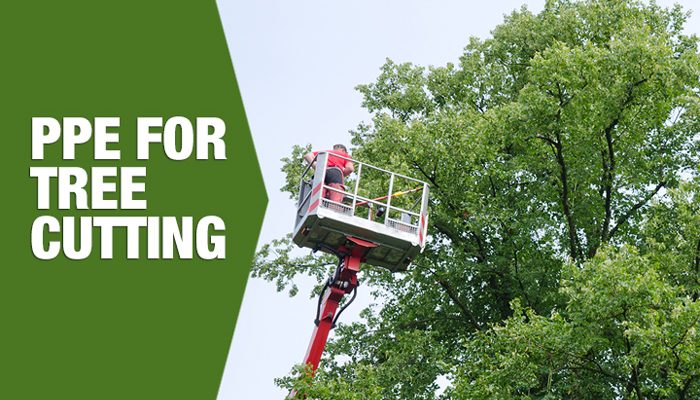
Tree Lopping Equipment
4 February 2018
Tree Lopping Equipment – Safety for arborists
Your pre-use risk assessment will determine if a spiderlift is the right equipment for tree work at height. Just as important as checking the suitability of the MEWP chosen for the task is checking the personal protective equipment (PPE) required by the operatives.
Serious accidents do occur in arboreal and forestry work. Tree work has a major incidence rate higher than the construction industry. Whether you own or hire a spiderlift, it is your responsibility to ensure staff are correctly trained and equipped.
PPE without a chainsaw
PPE for operatives using the basket but not a chainsaw should protect the head, feet, hands.
• The safety helmet should comply with BS EN 397 or BS EN 12492
• Protective boots complying with BS EN 345-1 should be worn
• Work gloves that are suitable for the task in hand
PPE with a chainsaw
Because of the inherent dangers of using a chainsaw whilst working at height, especially from flying sawdust and falling branches, protective equipment is essential. In addition to the head, feet and hands – eye, ear and leg protection are needed.
• As above the safety helmet should also comply with BS EN 397 or BS EN 12492
• Eye protection (especially from flying wood splinters) which can be either a mesh visor complying with BS EN 1731, or safety glasses to BS EN 166
• Hearing protection complying with BS EN 352
• Protective boots need to be stronger with good grip, protective guarding at the upper front and instep, and comply with BS EN ISO 20345. Look out for the chainsaw logo.
• Leg protection and groin protection complying with BS EN 381-5: Type A or C
• Appropriate gloves subject to the operator’s risk assessment
Additional PPE for all operatives
• Wear non-snag outer clothing – high visibility if justified by risk assessment
• Carry a personal first-aid kit that includes a large wound dressing
• Carry a suitable knife with a retractable blade
Summary
The wearing of Personal Protection Equipment by the tree-work gang is essential. Only trained and authorised people should operate the spiderlift. A spiderlift also requires minimum of two people to operate it and the ground staff must be able to operate the emergency controls on the platform below.
Promax Access specialise in providing high access tree cutting equipment for the Forestry industry and tree cutting services. We can offer a wealth of advice on choosing the right access platform for the job. Contact us now.
